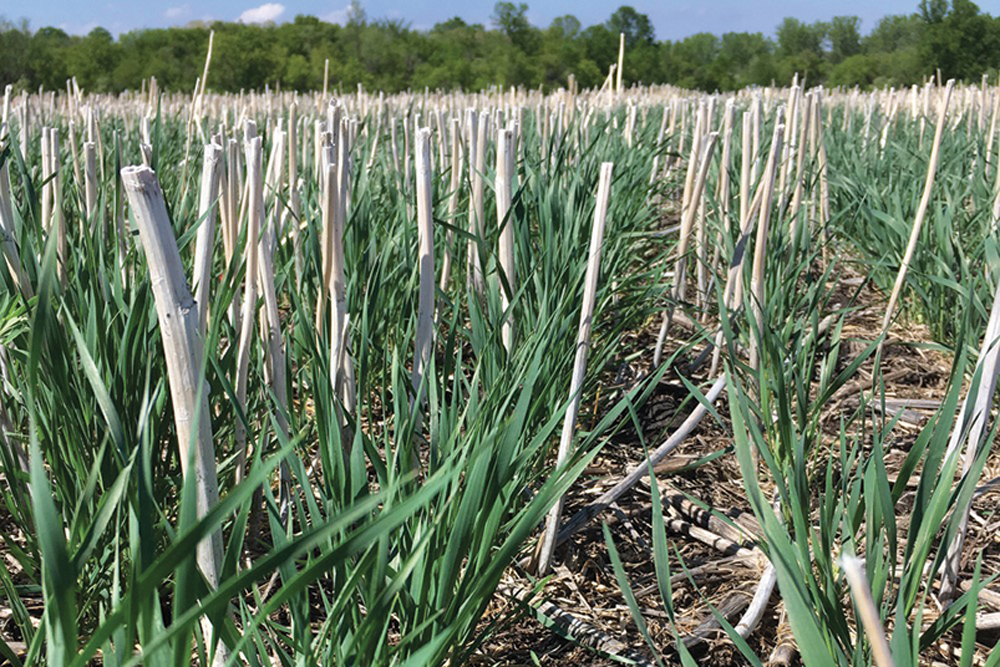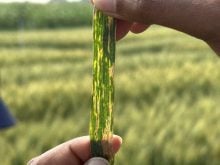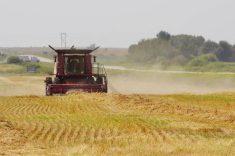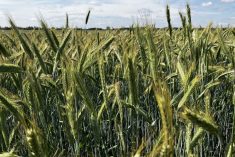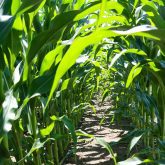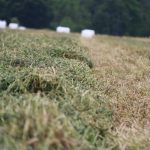Winter wheat and fall rye acreage in Manitoba has been declining in recent years, but an early harvest could see winter cereals bounce back.
“In terms of field selection, this is a much better year to be planning and planting winter cereal varieties than last year,” said Manitoba Agriculture crop extension specialist Anne Kirk.
Why it matters: Early September is flagged as an ideal planting window for winter cereals.
Read Also

Manitoba trials work toward drone spraying approvals
Canada’s PMRA says pesticides need drone-specific labels before drone spraying can take off; Manitoba crop trials are adding data towards that approvals process.
Last year, the entire season was shifted back a few weeks due to 2022’s wet spring. With a late harvest, there generally wasn’t enough suitable stubble for farmers to seed winter cereals in a timely manner, and stubble is a key factor to reduce winterkill.
“It was tough for some farmers to find canola stubble or other stubble that was ready in time for winter cereal planting,” Kirk said.
Conditions are better this year and Kirk has tips for farmers who plan to drag out the seeder in the next few weeks.

Getting good stubble
The best option is canola stubble, but when that isn’t available, research has shown barley and pea stubble are good alternatives. Kirk also noted insurance coverage depends on seeding into eligible stubble types.
“To optimize winter survival, we want the stubble to hold four inches or more of snow,” she said.
This layer of snow provides insulation for emerging winter cereal crowns.
Producers who know that winter cereals are in a field’s future should keep stubble in mind when taking off the spring crop. Height is one consideration, but stubble density also determines snow catch.
“We want to look at stubble height, stems per metre per row, and stubble rows per metre squared,” said Kirk. “Not only how tall that stubble is, but how much of that stubble is remaining after harvesting, harrowing and after all the traffic on the fields that comes with harvest time.”
Seeding dates
The insurance deadline for seeding winter cereals ranges from Aug. 15 to Sept. 25, and the extended coverage period runs from Sept. 26-30.
But Kirk recommends a slightly narrower window, between Aug. 25 and Sept. 25, for winter cereals.
“This really needs to have adequate time to develop healthy crowns and at least two to three leaves growing, heading into winter,” she said. “If we haven’t established a well-developed crown and those leaves, there is a higher risk of winterkill.”

Kirk points to a University of Manitoba study that looked at winter wheat seeding data across the Prairies.
“With early planting, we did see a yield reduction,” she said. “This is because seeding too early allows the crown to get too big before freeze up and leaves it more susceptible to freezing injury over the winter.”
The study also showed winter wheat can be planted into October and even early November at most sites and in most years.
Fall rye is a different story.
“We don’t think that there’s as much of a risk of winterkill with early seeding,” said Kirk. “But studies have shown that you’d have lower thousand-kernel weight and lower yields with early seeding and later seeding.”
Seeding depth
Kirk recommends a seeding depth of about one inch for both crops.
“Deeper seeding can result in decreased emergence and weak plants, which can cause severe winterkill,” she warned.
There’s often a temptation to plant seeds deeper to reach moisture further down in the soil, but Kirk said that is not necessarily effective. Temperature in fall and the time between seeding and freeze up have a greater influence on establishment than soil moisture, she said.
“We know that as little as about a third of an inch of rain is often enough to establish winter wheat. We don’t need as much rain for germination and emergence in the fall as we do in the spring because the soils are cooler and we have less evaporation on the surface.”
Seeding rates
For winter wheat, Kirk put the ideal crop density target at 20 to 30 plants per square foot.
“I’d recommend aiming for about 30 plants per square foot for a final plant stand,” she said.
That tracks with recent Alberta research that suggested producers aim for about 450 seeds per metre squared. When accounting for germination and mortality, that’s roughly equal to 30 seeds per square foot.
Fall rye has a very good ability to tiller, so rates are a bit lower.
Kirk noted hybrid fall rye is sold in units, not bushels, and the recommended seeding rate is one unit per acre. A unit is one million viable seeds.
“So, if you’re planting one million seeds per acre, you’re planting about 23 plants per square foot,” she said. “For open-pollinated fall rye, the target plant population would be 24 plants per square foot.”
Soil fertility
“Soil fertility can be a bit tricky for fall crops,” said Kirk.
Farmers can apply all nitrogen in the fall, all nitrogen in the spring, or do a split between fall and spring. Traditionally, spring application is more common.
“In wet climates like Manitoba, the standard was to apply all of this fertilizer for fall cereals in the spring because, if we applied it in the fall, we saw too many losses from volatilization and leaching,” Kirk said.
“In drier conditions, in areas like Alberta, the standard was to apply all in the fall because, if you applied in the spring, there’s a good chance that that fertilizer wouldn’t make its way down to the root for the plant to uptake it.”
Those trends may be shifting. Seasonal conditions are unpredictable and there are ways to mitigate risks associated with fall application, so split application is gaining ground in the province.
“In Manitoba, where we typically have [better] moisture conditions, a split application may be most prudent in terms of mitigating risks from both spring and fall applications,” Kirk said.
Varieties
She recommends using the seed guide when picking varieties.
The data from the Manitoba Agriculture’s 2023 winter wheat and fall rye trials is currently being analyzed and should be available soon. Last year, the top varieties of winter wheat were Emerson, Wildfire, Gateway and Network.
“Wildfire, Network, Coldfront and Vortex are all newer varieties from the Rob Graf breeding program that all have good potential in terms of high yields and fairly good disease packages,” said Kirk, referencing variety development work from Agriculture and Agri-Food Canada in Lethbridge, Alta.
“We have seen much more interest in open-pollinated fall rye varieties, which require different management,” she added.
Last year open-pollinated fall rye varieties exceeded hybrid varieties in terms of acres planted, she noted. There is a difference of about 20 bushels per acre in yield between hybrids and open-pollinated varieties, depending on growing conditions and management.
Weed management
Winter cereals can be a good option in the battle against weeds.
“A dense stand of winter cereals can offer very good weed competition, especially against those annual weeds that emerge in the spring,” said Kirk. “It’s a good time to choke out some of those weeds.”
But she cautioned that winter annuals and perennial weeds can be an issue.
Kirk recommended pre-emergence herbicide application as an effective way to control problem weeds and set up the crop for successful establishment.
“If those winter annual weeds are an issue, but weren’t controlled prior to emergence, then the most effective time for control would be in the fall, prior to freezing,” she said.
Farmers should consult Manitoba’s Guide to Field Crop Protection for herbicide options.


